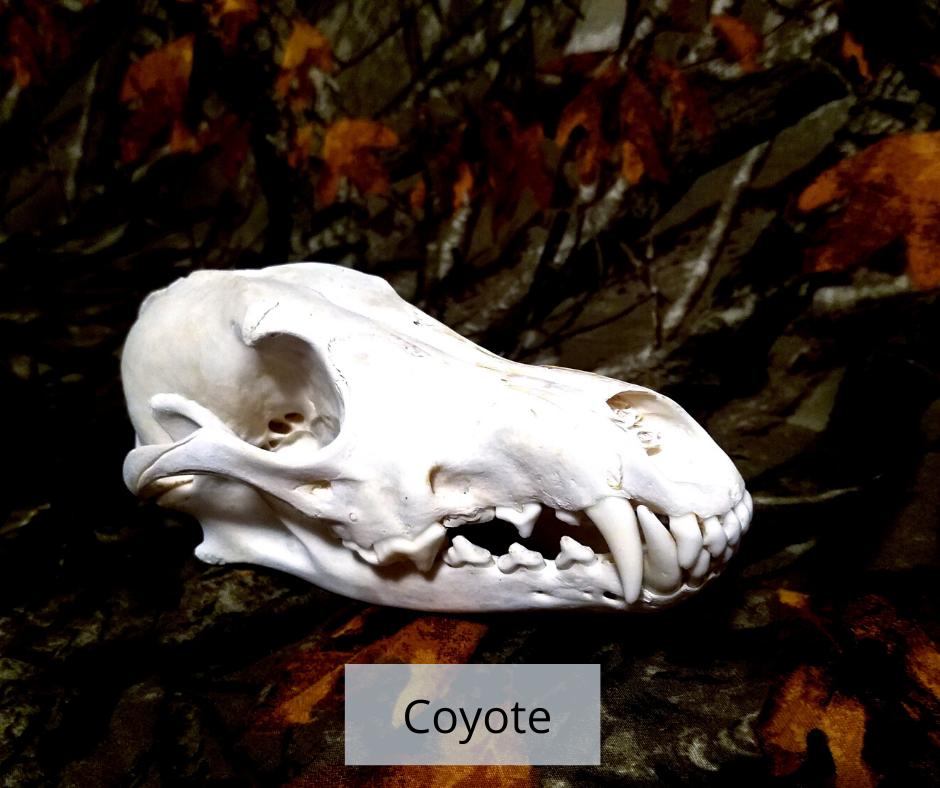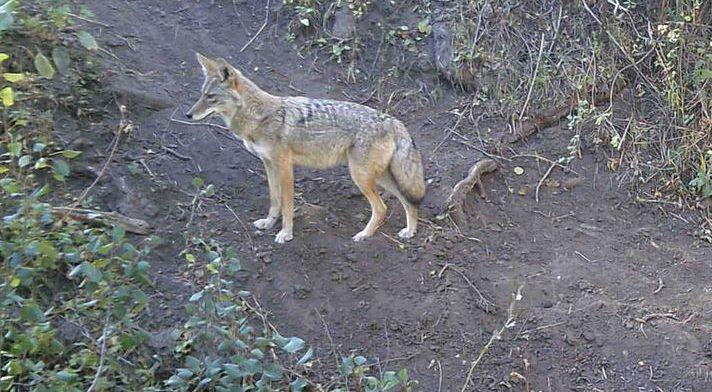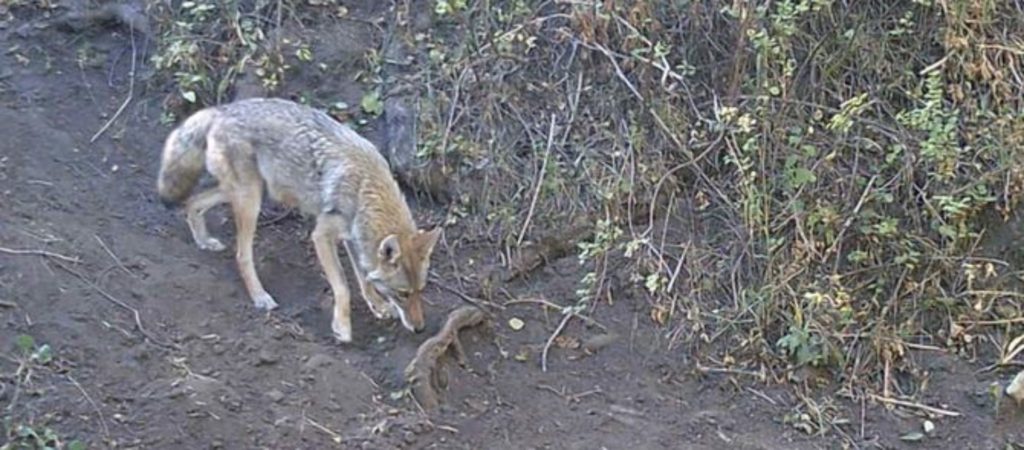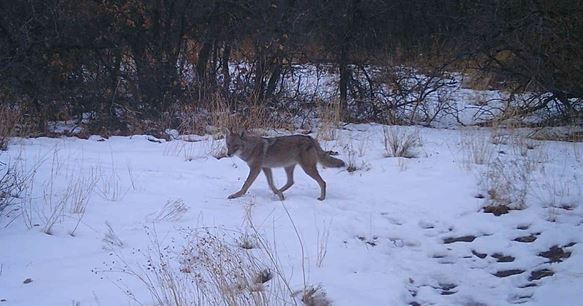Coyotes are one of the most prevalent mammals in the United States. It is very common to find one on your trail cameras no matter where you are setting them up, including inside cities and towns. The coyote is able to adapt to almost any habitat.
Coyote Characteristics
Coyote Size
Coyotes are definitely not the biggest predator in the wild. An adult coyote is usually between 2 and 1/2 feet long (excluding tail) to 3 and 1/2 feet long. Coyotes will also weigh between 25 to 50 pounds. Because coyotes are so small, it is not uncommon to see them hunting and traveling in groups. A group of coyotes is called a band. Coyotes band together to help hunt and scavenge for food. In large groups, coyotes are more able to bring down big game like deer and elk.
Coyote coloring
Like most animals, coyotes come in all different colors. They normally are a mix of tan, grey, black, and white.
However, like most animals, they can have conditions like albinism and melanism that affect the pigment of their skin and fur. These two conditions can make the coyote’s fur either completely black or white. These conditions are very rare and make black coyotes are very rare as well as white coyotes!
Coyote Pup/ Baby
Coyote pups share a lot of similar features as their parents do when they are about a month or two old. When they are just born they are usually just a solid brown color.
Coyote Skull
A Coyote skull is very similar to the normal household dogs skull.

Coyotes tracks
Because coyotes are a subspecies of dogs, their tracks look just like dogs. They will have 4 toe pads with one main pad in the center of their foot. They will also have 4 claw marks coming off of each of the toe pads. Coyote tracks will be about 2 to 3 inches long and an inch to 2 inches wide. (See picture below) This can make identifying a coyote’s tracks very difficult especially in areas near cities where dogs are common. If you are trying to see if coyotes are in your area and you see a track below, we recommend setting up a trail camera to see what animal made these tracks, especially if you find them near places with dogs or foxes. It helps a lot to be able to find some of their poop or scat in the area to help identify their tracks.

Coyotes poop / Scat
Identifying coyote poop is actually a little easier than their tracks. Coyote scat or poop is a great way to identify their tracks. A coyote’s poop will always be about the size of a normal house dog’s, but the main difference is that a coyote’s scat will have hair/ fur in it. This is the biggest factor in identifying their scat. A normal dog’s poop will not normally be filled with hair. This is because a coyote’s diet will mainly consist of other animals like deer, elk, and squirrels. A dog’s normal food will not have hair/fur in it because they are usually fed bagged dog food from the store.

What do Coyotes Eat?
Coyotes are predators and scavengers. Coyotes will eat any animals that have died that they find. They will also hunt other animals. Their normal diet consists of squirrels, rabbits, mice, deer, elk, and turkeys. The coyote in the video below is hunting with another coyote that is not in the camera. In the video you can see the coyote starting to corner the turkeys towards the other coyote.
Coyote Sounds
Coyotes make a few different noises to communicate different emotions and to find other coyotes.
Coyote Howling
Coyotes howl for a couple of different reasons. The first is that they are social animals. Coyotes will howl to find other coyotes and let other coyotes know where their territory is. The second reason they howl is just for fun. They will howl to show excitement and happiness. Check out the awesome video below to hear what it sounds like. (They are loud!)
Growl and Bark
Coyotes also growl and bark like your common house dog. Like dogs coyotes bark to show excitement and get attention. They will also growl to be menacing and show that they are dangerous.
Coyotes and Similar Animals
The coyote has a lot of similar characteristics to other wildlife. This can make identifying them difficult if you are not familiar with different animals.
Coyote VS Wolf
One of the main differences between coyotes and wolves is size. Coyotes are usually between 2 and 1/2 feet long to 3 feet long and weigh between 25 to 50 pounds. Wolves on the other hand can be 3 and 1/2 feet long to almost 6 feet long and weigh between 150 and 200 pounds. Wolves are also more likely to be white and black than a coyote. A coyote is only white or black if it has a skin condition like albinism, melanism, or leucism. Wolves will also travel in larger groups than coyotes.
Coyote VS Fox
Because there are a number of different species of foxes it can be very difficult to tell the difference between some foxes and coyotes. The biggest difference between coyotes and foxes is usually their color. Usually, foxes have more red than coyotes do in their fur. Foxes are also usually a lot smaller than coyotes.
Coyote and Badger
Not too long ago a trail camera video of a badger and a coyote traveling together through a pipe. (see videos below) Contrary to popular belief they are not friends. They are simply hunting together. A lot of people don’t realize this but if the coyote or badger is hungry enough they will attack and eat each other. This is a rare occurrence that happens where the two animals rely on each other to hunt and get food.
Coyote Pictures
Using trail cameras is the easiest way to get awesome pictures or videos of coyotes. To get the best pictures of coyotes the best thing to try doing is to find their food. This means if you can find deer, elk, or rabbits you will most likely have coyotes in the area as well. If you would like to see our gallery of coyotes click the coyote pictures below! Also if you need tips on how to get more wildlife on trail cameras click the trail camera tips button!
Are Coyotes Dangerous
The simple answer is YES! Coyotes are predators and normally do not pose too much of a threat to humans. However, they are known to attack humans on rare occasions. (see video below) Coyotes are natural predators and can attack without warning. I have personally been chased by a small group of coyotes in Arizona near Queen Creek.
Coyote Hunting
In most states, coyotes are considered nuisance animals. This is mostly because of the number of coyotes there are and their ability to cause large amounts of damage to either livestock, pets, and people. This means that most states do not regulate the hunting of coyotes. Some states, like Utah, even offer bounties for killing coyotes to help regulate their numbers. In Utah, the bounty for coyotes is $50 dollars for every coyote.
Coyotes can be hunted in many different ways. You can spot and stalk, use coyote calls, or trap them.
Coyote Calling
Coyote calling can be very hard. Coyotes are incredibly smart and can outsmart some of the best hunters out there. There are mainly 2 different types of calls that you can use. Those are hand calls and electric callers. These calls with practice can bring coyotes within a few yards of the hunter and help them be successful. If you need tips on calling coyotes click below on the Coyote calling tips button!
Coyote Trapping
Trapping is incredibly hard and can pose a significant challenge to sportsmen. Coyotes are incredibly smart and it can be counted as a significant accomplishment when one is able to catch a coyote in any trap. When we trap we make sure to use trail cameras! Click below to see why!







